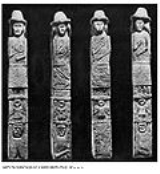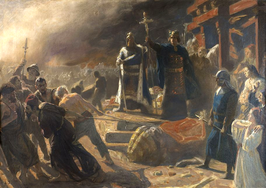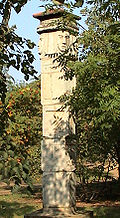
Svetovid
Encyclopedia



Russian language
Russian is a Slavic language used primarily in Russia, Belarus, Uzbekistan, Kazakhstan, Tajikistan and Kyrgyzstan. It is an unofficial but widely spoken language in Ukraine, Moldova, Latvia, Turkmenistan and Estonia and, to a lesser extent, the other countries that were once constituent republics...
and Bulgarian
Bulgarian language
Bulgarian is an Indo-European language, a member of the Slavic linguistic group.Bulgarian, along with the closely related Macedonian language, demonstrates several linguistic characteristics that set it apart from all other Slavic languages such as the elimination of case declension, the...
, and alternative name in Serbo-Croatian
Serbo-Croatian language
Serbo-Croatian or Serbo-Croat, less commonly Bosnian/Croatian/Serbian , is a South Slavic language with multiple standards and the primary language of Serbia, Croatia, Bosnia and Herzegovina, and Montenegro...
), Svyatovit (Ukrainian), Svyatovid (alternative name in Ukrainian), Svyentovit (alternative name in Ukrainian), Svetovid (Serbian
Serbian language
Serbian is a form of Serbo-Croatian, a South Slavic language, spoken by Serbs in Serbia, Bosnia and Herzegovina, Montenegro, Croatia and neighbouring countries....
, Croatian
Croatian language
Croatian is the collective name for the standard language and dialects spoken by Croats, principally in Croatia, Bosnia and Herzegovina, the Serbian province of Vojvodina and other neighbouring countries...
, Slovenian
Slovenian language
Slovene or Slovenian is a South Slavic language spoken by approximately 2.5 million speakers worldwide, the majority of whom live in Slovenia. It is the first language of about 1.85 million people and is one of the 23 official and working languages of the European Union...
, Macedonian
Macedonian language
Macedonian is a South Slavic language spoken as a first language by approximately 2–3 million people principally in the region of Macedonia but also in the Macedonian diaspora...
and Bosnian
Bosnian language
Bosnian is a South Slavic language, spoken by Bosniaks. As a standardized form of the Shtokavian dialect, it is one of the three official languages of Bosnia and Herzegovina....
, and alternative name in Bulgarian), Suvid (alternative name in Serbian, Croatian and Bosnian), Svantevit (Wendish, alternative name in Ukrainian and possibly proto-Slavic
Proto-Slavic language
Proto-Slavic is the proto-language from which Slavic languages later emerged. It was spoken before the seventh century AD. As with most other proto-languages, no attested writings have been found; the language has been reconstructed by applying the comparative method to all the attested Slavic...
), Svantevid (alternative name in Serbian , Croatian and Bosnian), Svantovit (Czech
Czech language
Czech is a West Slavic language with about 12 million native speakers; it is the majority language in the Czech Republic and spoken by Czechs worldwide. The language was known as Bohemian in English until the late 19th century...
), Svantovít (Czech), Svantovid (alternative name in Serbo-Croat and Bosniak), Swantovít, Sventovit, Zvantevith (Latin and alternative name in Serbo-Croatian), Świętowit (Polish
Polish language
Polish is a language of the Lechitic subgroup of West Slavic languages, used throughout Poland and by Polish minorities in other countries...
), Światowid, Sutvid, Svevid, Vid and, incorrectly, Światowit, is the Slavic
Slavic mythology
Slavic mythology is the mythological aspect of the polytheistic religion that was practised by the Slavs before Christianisation.The religion possesses many common traits with other religions descended from the Proto-Indo-European religion....
deity of war, fertility and abundance, sometimes referred to as Beli (or Byali) Vid, Beli = white, bright, shining.
He always carries his sword (sometimes bow) in one hand, and in the other a drinking horn. Svetovid had a white horse
White horse (mythology)
White horses have a special significance in the mythologies of cultures around the world. They are often associated with the sun chariot, with warrior-heroes, with fertility , or with an end-of-time saviour, but other interpretations exist as well...
which was kept in his temple and taken care of by priests. It was believed Svantevit rode this horse in battle. The horse was used for divination. Victory in battle, merchant travels and a successful harvest all depended on Svantevit.
Many of modern researchers see Svetovid as a Rugian counterpart of the all-Slavic Perun common in Slavic mythology.
Appearance
Svetovid is associated with war and divinationDivination
Divination is the attempt to gain insight into a question or situation by way of an occultic standardized process or ritual...
and depicted as a four-headed god with two heads looking forward and two back. A statue portraying the god shows him with four heads, each one looking in a separate direction, a symbolical representation of the four directions of the compass, and also perhaps the four seasons of the year. Each face had a specific colour. The northern face of this totem was white (hence Byelorus and the White Sea), the western, red (hence Chervona Rus'), the southern, black (hence the Black Sea) and the eastern, green (hence Zelenyj klyn).
Etymology
Boris RybakovBoris Rybakov
Boris Alexandrovich Rybakov was a Soviet and Russian historian who personified the anti-Normanist vision of Russian history....
argued for identification of the faces with the gods Perun
Perun
In Slavic mythology, Perun is the highest god of the pantheon and the god of thunder and lightning. His other attributes were the fire, mountains, the oak, iris, eagle, firmament , horses and carts, weapons and war...
, Svarog
Svarog
Svarog is a Slavic deity known primarily from the Hypatian Codex, a Slavic translation of the Chronicle of John Malalas. Svarog is there identified with Hephaestus, the god of the blacksmith in ancient Greek religion, and as the father of Dažbog, a Slavic solar deity...
, Lada
Lada and Lado
Lada or Lado is the names of a putative Slavic pagan deity of harmony, merriment, youth, love and beauty .The word 'Lado' does indeed appear in many Slavic and Baltic wedding and folk songs, particularly those sung during Ivan Kupala and other summer festivals. Its meaning, if indeed it has any, is...
and Mokosh
Mokosh
Mokoš is a Slavic goddess attested in the Primary Chronicle, connected with female activities such as shearing, spinning and weaving....
(compare Zbruch idol
Zbruch Idol
The Zbruch Idol is a 9th century sculpture, and one of the rarest monuments of pre-Christian Slavic beliefs. The pillar is commonly associated with the Slavic deity Svantevit, although opinions on the exact meaning of all the bas-reliefs and their symbols differ...
). Joined together, they see all four sides of the world. This gave rise to a false etymology of the name of the god as "world-seer" (svet = "world", vid = "sight"; Svetovid = "worldseer"). However, the forms Sventevith and Zvantewith show that the name derives from the word svętъ, meaning "saint, holy". The second stem is sometimes reconstructed as vit = "lord, ruler, winner".
The name recorded in chronicles of contemporary Christian monks is Svantevit, which, if we assume it was properly transcribed, could be an adjective meaning approx. "Dawning One" (svantev,svitanje = "dawning, raising of the Sun in the morning" + it, adjective suffix)), implying either a connection with the "Morning Star" or with the Sun itself.
Worship
The main temple of Svantevit, as he was called by the local RaniRani (Slavic tribe)
The Rani or Rujani were a West Slavic tribe based on the island of Rugia and the southwestern mainland across the Strelasund in what is today northeastern Germany....
, was located in Arkona
Cape Arkona
Cape Arkona is a cape on the island of Rügen in Mecklenburg-Vorpommern, Germany. Cape Arkona is the tip of the Wittow peninsula, just a few kilometres north of the Jasmund National Park....
on Rugia Island in the Baltic Sea
Baltic Sea
The Baltic Sea is a brackish mediterranean sea located in Northern Europe, from 53°N to 66°N latitude and from 20°E to 26°E longitude. It is bounded by the Scandinavian Peninsula, the mainland of Europe, and the Danish islands. It drains into the Kattegat by way of the Øresund, the Great Belt and...
(today Rügen, in Germany
Germany
Germany , officially the Federal Republic of Germany , is a federal parliamentary republic in Europe. The country consists of 16 states while the capital and largest city is Berlin. Germany covers an area of 357,021 km2 and has a largely temperate seasonal climate...
).
The island of Rügen or Danish Rugia was named after the Germanic tribe of the Rugii, who lived at the Baltic Sea
Baltic Sea
The Baltic Sea is a brackish mediterranean sea located in Northern Europe, from 53°N to 66°N latitude and from 20°E to 26°E longitude. It is bounded by the Scandinavian Peninsula, the mainland of Europe, and the Danish islands. It drains into the Kattegat by way of the Øresund, the Great Belt and...
in Magna Germania. Later newcomers retained similarity to the name as Rani or Rujani.
The original name of the island was Rujan (meaning red in Old Slavic); thus the name would in translation imply 'The Red Island'.
The autochthonous inhabitants of the island were the Slavic tribe, the Rujani, whose name was cognate with the island's; thus translating as people from Rujan. After the destruction and Germanization of the Rujani by the Danes
Danes
Danish people or Danes are the nation and ethnic group that is native to Denmark, and who speak Danish.The first mention of Danes within the Danish territory is on the Jelling Rune Stone which mentions how Harald Bluetooth converted the Danes to Christianity in the 10th century...
, in 1168, the original Slavic name of Rujan was corrupted as Rügen in German and Rugia in Danish.
According to various chronicles, the temple contained a giant wooden statue of Svantevit depicting him with four heads (or one head with four faces) and a horn of abundance. Each year the horn was filled with fresh mead
Mead
Mead , also called honey wine, is an alcoholic beverage that is produced by fermenting a solution of honey and water. It may also be produced by fermenting a solution of water and honey with grain mash, which is strained immediately after fermentation...
.
The temple was also the seat of an oracle
Oracle
In Classical Antiquity, an oracle was a person or agency considered to be a source of wise counsel or prophetic predictions or precognition of the future, inspired by the gods. As such it is a form of divination....
in which the chief priest predicted the future of his tribe by observing the behaviour of a white horse identified with Svantevit and casting dice
Dice
A die is a small throwable object with multiple resting positions, used for generating random numbers...
(horse oracles have a long history in this region, being already attested in the writings of Tacitus). The temple also contained the treasury of the tribe and was defended by a group of 300 mounted warriors which formed the core of the tribal armed forces.
Origins
Some interpretations claim that Svetovit was another name for RadegastRadegast (god)
Radegast, also Radigost, Redigast, Riedegost or Radogost, is mentioned by Adam of Bremen in his Gesta Hammaburgensis Ecclesiae Pontificum as the deity worshipped in the Lutician city of Rethra. Likewise, Helmold in his Chronica Slavorum wrote of Radegast as a Lutician god...
, while another states that he was a fake god, a Wendish construction based on the name St. Vitus. However, the common practice of the Christian Church was to replace existing pagan deities and places of worship with analogous persons and rituals of Christian content, so it seems more likely that Saint-Vitus was created to replace the original Svanto-Vit. According to a questionable interpretation, Svantevit was a Rugian
Rügen
Rügen is Germany's largest island. Located in the Baltic Sea, it is part of the Vorpommern-Rügen district of Mecklenburg-Vorpommern.- Geography :Rügen is located off the north-eastern coast of Germany in the Baltic Sea...
counterpart of the all-Slavic Perun
Perun
In Slavic mythology, Perun is the highest god of the pantheon and the god of thunder and lightning. His other attributes were the fire, mountains, the oak, iris, eagle, firmament , horses and carts, weapons and war...
common in Slavic mythology
Slavic mythology
Slavic mythology is the mythological aspect of the polytheistic religion that was practised by the Slavs before Christianisation.The religion possesses many common traits with other religions descended from the Proto-Indo-European religion....
.
In Croatia, on the island of Brač, the highest peak is called Vid's Mountain. In the Dinaric Alps
Dinaric Alps
The Dinaric Alps or Dinarides form a mountain chain in Southern Europe, spanning areas of Slovenia, Croatia, Bosnia and Herzegovina, Serbia, Kosovo, Albania and Montenegro....
there is a peak called "Suvid" and a Church of St. Vid. Among the Serbs, the cult of Svetovid is partially preserved through the Feast of St.Vitus, "Vidovdan
Vidovdan
-See also:*Divinity*Daeva*Deva *Vidovdan...
," one of the most important annual events in Serbian Orthodox Christian tradition.
Science fiction
The science fiction story "Delenda EstDelenda Est
"Delenda Est" is a short story written by Poul Anderson, part of his Time Patrol series. The title alludes to the Latin phrase Carthago delenda est from the Third Punic War.-Plot summary:...
" by Poul Anderson
Poul Anderson
Poul William Anderson was an American science fiction author who began his career during one of the Golden Ages of the genre and continued to write and remain popular into the 21st century. Anderson also authored several works of fantasy, historical novels, and a prodigious number of short stories...
depicts an alternate history world where Carthage
Carthage
Carthage , implying it was a 'new Tyre') is a major urban centre that has existed for nearly 3,000 years on the Gulf of Tunis, developing from a Phoenician colony of the 1st millennium BC...
defeated Rome
Rome
Rome is the capital of Italy and the country's largest and most populated city and comune, with over 2.7 million residents in . The city is located in the central-western portion of the Italian Peninsula, on the Tiber River within the Lazio region of Italy.Rome's history spans two and a half...
, Christianity never arose and in the 20th Century, Svantevit is still a main deity of a major European power called Littorn (that is, Lithuania
Lithuania
Lithuania , officially the Republic of Lithuania is a country in Northern Europe, the biggest of the three Baltic states. It is situated along the southeastern shore of the Baltic Sea, whereby to the west lie Sweden and Denmark...
). A devotee of this god, in the story, is called Boleslav Arkonsky – a name evidently derived from the abovementioned temple at Arkona.

